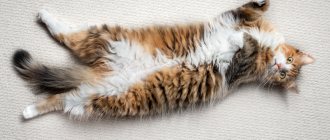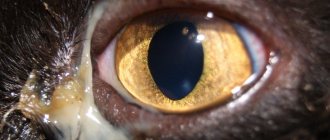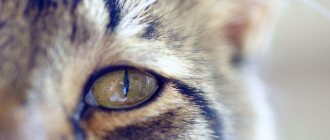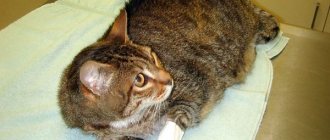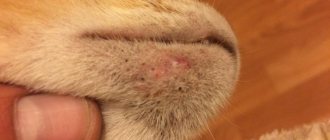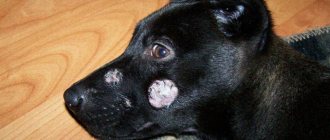Why do cats have hot paws?
A loving owner always pays great attention to the condition of his pet and, if necessary, is ready to begin treatment in a timely manner. Sometimes, noticing that a cat has hot paws, as well as a nose and ear, a person begins to seriously worry, trying to find an explanation for this phenomenon. Most often, such a condition of a cat should not cause concern, as it is explained by natural causes. It is also worth remembering that a cat’s temperature is higher than a person’s.
However, there are still a number of cases when a cat needs veterinary care. In order to accurately understand when everything is fine with your pet, and when he needs the help of a specialist, you need to find out the main reasons why an increase in paw temperature may occur. We must not forget that if a cat’s nose is dry and hot, then this is a reason to visit a doctor.
A cat's nose as an indicator of well-being
The main function of a cat's nose is olfactory. Thanks to numerous (almost 20 times more than in humans) receptors, it helps completely blind kittens to freely navigate in space from birth. Babies deprived of sight and hearing always find their mother by reacting to surrounding smells.
The nasal sinuses are separated by a cartilaginous septum, and immediately behind them are the ethmoidal conchae. All odors entering this section are transmitted by receptors directly to the brain, which identifies the sniffed object or subject. The nasal bones of flat-faced breeds are deformed, making it more difficult for them to recognize odors and have a harder time breathing.
In addition to the olfactory, it is important to note the protective and tactile functions. The inhaled air is filtered inside the sinuses to remove dust and microorganisms and warms up to a comfortable temperature. The tactile function is performed by the lobe. This is what cats use to determine the temperature of food.
For the owner of a mustachioed pet, the latest function remains important, allowing you to assess your well-being without undergoing tests. If the animal is healthy, then its lobe:
- a little shiny;
- cool;
- wet;
- has no crusts or scales.
Humidity is achieved thanks to a special secretion secreted by the mucous membranes. It creates a protective film that protects the cat from the adverse effects of external factors, and helps to retain molecules of foreign substances to recognize their odors. Also, the wetness of the nose is associated with frequent licking, characteristic of the cat family.
Causes
You can talk about health problems in a situation where the cat’s paws suddenly become hot, and this was not preceded by prolonged exposure to high temperature or, conversely, cold (the pads then become very hot for 1-2 hours). In this case, it is worth examining his limbs. If a cat has had hot paws since childhood, then this phenomenon is normal and similar to what occurs in some people, when their hands are always hot, and even in severe frost they can walk without gloves.
The pathological reasons why a cat's paws become hot are:
- Trauma - in this case, in addition to a local increase in temperature, there are also external manifestations. The main ones are swelling, the presence of a wound or hematoma, as well as acute pain in the paw, due to which the pet does not allow a full examination of it. The hind and forelimbs may be affected. A dog, even during play, if it is large, can damage the cat;
- Stinging insect bite - just like in humans, when a cat is struck by a wasp or bee, a local increase in temperature occurs in the affected area. The paws are most often affected, causing them to become hot and swollen. Treatment is aimed at relieving swelling and allergic reactions, as well as disinfecting the wound. If there is no acute general allergy, the prognosis for the pet is favorable. A sign that just such a “disease” is occurring is a visible bite site. A veterinarian can easily diagnose such a problem;
- Chemical irritation of the skin of the paws - this phenomenon can occur if, during a walk or at home, due to the carelessness of the owner, the animal stepped into a caustic chemical composition. In such a situation, the paw pads get burned and become inflamed, causing a local increase in temperature. With chemical damage, it also becomes noticeable that it is painful for the animal to stand on its paws. This condition does not last for a single day in a cat. The question of what treatment is needed is decided by the veterinarian;
- Allergies – it is possible that the temperature of the paws may increase even at the moment when the food is changed. It appears in one or two days. In this case, as in humans, a skin reaction occurs, in which redness of individual areas of the skin is noted, followed by a local increase in temperature, which causes the paws to become hot. If you carefully examine the cat's body, local rashes will be found on it, similar to those observed with allergies in humans. Also in this situation, the cat often has hot ears and paws.
If the paws suddenly become hot, you should definitely show the animal to a specialist. Hot paws on a kitten may indicate that it is infected with worms.
Source
Hot paws - main causes and symptoms
There are many pathological reasons for which a cat’s hot paws are the main symptom. The following problems and diseases can provoke an increase in temperature:
- Serious injury. The temperature of the paws especially often increases if the animal has fallen from a height or been injured during play. The main sign of injury is that the pet falls and staggers when walking, coordination of movements is impaired, and the animal’s appetite disappears.
- Insect bites. Both in humans and in animals, blood circulation in the affected area is disrupted, which results in an increase in temperature. It is recommended to carefully examine the pads - a bite is indicated by a large, hard blister.
- Chemical burn. If, during a walk, an animal steps in a caustic compound or, out of curiosity, turns over a bottle of a chemical at home, there is a risk of serious tissue damage, which leads to increased paw temperature and an inflammatory process. Symptoms of a chemical burn include red spots and severe peeling of the affected areas.
Hot paws on your pet may also indicate an allergic reaction to food. A skin reaction begins, individual areas turn red, and a local temperature change is observed.
Rarely, hot paws on a pet may indicate a helminthic infestation. It is recommended to carefully examine the animal's feces - if there is severe infection, particles of parasites will be observed in the feces.
The cat has warm paws: the reason and when to worry
Cats use their paws to groom themselves (especially to clean the most difficult parts, reaching the ears, neck, face and chin), but their paws are also used for jumping and for communicating with other animals because they release pheromones. That's not all. Cats sweat through their paws because they contain sweat glands. This cooling system is very useful to prevent your cat from overheating, especially in summer.
If you notice that your cat has hot paws, this is most likely a sign of a fever, in which case you should observe his behavior to determine the severity of the situation.
Characteristics of cat paws
Cats' feet are very special, they have retractable claws and walk using the pads of their feet. Thanks to this, the cat moves quickly and silently over any terrain.
The pads are made up of many elastic fibers and dense fatty tissue, but their main characteristic is that cats sweat through them. Sometimes sweating increases when your cat is exposed to stressful situations, such as if you have to take him to the vet.
Another feature of cats is that the sweat glands of the pads secrete a fragrant oil that carries pheromones. The scent is unique to each cat and is used to mark its territory. With each step, the cat delineates its space and establishes its domain.
When your cat marks a piece of furniture, wood or any other surface with her claws, she leaves her exclusive signature and tells her peers that this is her home.
The cat has hot paws - the veterinarian's answer
Your cat's paws may be warm for several reasons. Firstly, the average body temperature of a cat is between 37.5 and 39 degrees. Compared to our body temperature of 36.6, our animals will be hot.
Another reason is that a cat's paws are heat-restricted areas because they don't sweat like we do. This means they sweat through their paws. Sometimes excessive heat in the paws can be a sign of overheating - either due to a fever or because your kitten is too hot due to the ambient temperature. However, this will be accompanied by signs other than warm paws, such as lethargy, lameness, vomiting, or loss of appetite . — Erin Clifford, Certified Veterinary Technician.
© shutterstock
The opposite problem is that the nose is too wet.
Although wetness is the recommended condition for a cat's nose, in some situations it can indicate pathology. Such exceptions include:
- Cold
. Due to a runny nose and frequent sneezing, the earlobe does not have time to dry out.
- Allergy
. The number of discharges correlates with colds. The only difference is that the symptoms disappear soon after the allergen is eliminated.
- Tumors, polyps and foreign objects
. Trying to get rid of the obstacle, the body produces an increased amount of mucus. If internal damage occurs, the discharge may contain blood or pus.
- Hypothermia or poisoning
. In addition to mucosal sputum, a decrease in temperature is noted.
- Infections
. Hot ears and copious discharge from the sinuses are characteristic of rhinotracheitis and panleukopenia.
- Cardiovascular diseases
. The appearance of increased humidity is accompanied by blanching of the mucous membrane.
This variety of possible interpretations confirms the danger of self-medication. An incorrect diagnosis can lead to aggravation of the real problem and deterioration of the animal's condition.
What to do
If you came here reading this article, you may have noticed that your cat's paws are warmer than usual. You should know that this part of the body is a real natural thermometer. To find out if your cat is ok, simply touch its paws: if they are hot enough, then the cat has a fever, yes, it has a fever.
You should know that, unlike humans, the body temperature of a healthy cat is 38.5°C, while the body temperature of a cat with a fever is above 39°C. If your cat has a temperature of around 41°C, you should contact your veterinarian immediately. The easiest and most direct way to tell if your cat has a fever is to measure it with a thermometer, but if you don't know how to do this, and if the cat won't let you take its temperature, there are other symptoms that may be reported if it has a fever. cats fever
Diagnosis and treatment
On the eve of a visit to the veterinarian, it is worth taking your furry's temperature.
Hot ears are an indicator of increased body temperature. If they turn red, this is a sign of high blood pressure. At home, before taking the animal to the veterinarian, you should measure the temperature. To do this, the tip of the thermometer must be smeared with Vaseline and inserted into the anus a couple of centimeters. The measurement duration should be approximately 3-4 minutes.
If the cat is nervous, shaking its head and scratching its ears, it is recommended to examine them. If there are signs of ear mites, the doctor prescribes a series of tests, such as examination under a microscope, scraping, and only after that prescribes treatment. As a rule, it consists of thoroughly washing the ear shells with vegetable oil, and prescribing blood purifying drugs and painkillers. When otitis develops, the veterinarian prescribes warm lotions and ear drops for cats. In stressful situations, when they affect the pet’s health, sedatives are prescribed, and valerian may be taken. If a cat has a bowel disorder, which is accompanied by an increase in temperature, you need to review the diet and introduce fermented milk products.
Why do cats have hot paw pads? If a cat has hot ears, what does it mean and what to do?
If a cat has hot ears, what does it mean and what to do?
Cats have a normal body temperature higher than humans, so sometimes your pet's ears may seem hot. To check if your pet is sick, you need to touch his nose; if it is wet and cool, then there is no need to worry. A dry and warm nose signals illness: - infection; - injuries; - inflammation; — diseases of the gastrointestinal tract; - stones in the bladder.
The pet's temperature is immediately measured; 38-39 is considered normal. Observe the behavior of the animal; if the cat has become lethargic, sleepy, and constantly lies down, then this indicates ill health. If you have any alarming symptoms, you should immediately contact your veterinarian. The pet needs to be given time, taken care of, and provided with proper care.
You can lower the temperature at home by using echinacea or astragalus tincture. The dose is calculated based on the weight of the animal, 8-10 drops of tincture per 10 kg. Give the cat a bowl of water, because at a temperature the pet will drink a lot.
If a cat has hot ears and paws, a warm dry nose, what does this mean?
A warm and dry nose combined with hot ears are signs that your pet is sick. The animal has an elevated body temperature, which is associated with diseases - infections, inflammation, gastrointestinal diseases.
If the cat's behavior is normal, without lethargy, then perhaps the pet is simply overheated. This is not scary, but it is still better to measure the temperature.
The cat has hot ears but a cold nose after childbirth, cesarean section, sterilization
After giving birth or cesarean section, cats may have a slight increase in temperature for a couple of days, this is not a cause for concern. Of course, if the ears are hot and the nose is wet and lethargic for several days, then it is possible that the pet has a very high fever and needs to immediately contact a veterinarian.
Sterilization should not cause a fever; the cat may have hot ears and a wet nose - this is normal. But if your nose is dry and hot, then you should immediately consult a doctor.
The cat has hot ears and head after castration, is a wet nose normal or not?
If a cat has been neutered, his ears may become warmer, but there should be no fever. Your pet needs supervision and care to make recovery from anesthesia easier. A wet nose and a hot head are an indicator that the cat does not have a fever.
The normal body temperature of a cat is 38-39.5°C. For a person, this temperature indicator is on the verge of critical. Therefore, touching a cat and feeling that the cat is hot
, the owners begin to panic.
Don’t be nervous right away, first measure your pet’s temperature - this is relative to your body temperature. The cat is hot
, but for him the temperature is within the normal range.
Also just a hot nose on a cat
, in the absence of any other symptoms, is by no means an indicator of ill health.
The cat has just woken up; in a few minutes the temperature balance will be restored. The animal is scared or nervous; stress is a common reason why a cat is hot.
The heat caused by these reasons, after a short time,
the cat's hot nose
will return to normal temperature.
Symptoms of fever in cats and kittens
But if the thermometer shows over 39.5°C, and the cat has hot ears and a dry nose,
There are reasons for concern, especially if you have symptoms such as:
- The cat refuses food and water; General lethargy, drowsiness; The cat's ears are hot
, red, swollen, with an unpleasant odor;
Hides from the light, from hands, behaves inappropriately; The cat's nose is hot and dry
, with dried purulent crusts;
Signs of a cold (sneezing, coughing, runny nose, eyes).
Explanation Why the Cat Is Hot
in this case, there can be one thing - there is an inflammatory process in the body.
The cat has hot ears
There are also other reasons:
- head and ear injury, infectious or viral disease;
Reduced body temperature in cats
If a pet's temperature is below 37C, this condition indicates problems in the animal's body.
Causes of hypothermia:
- depression, drowsiness, apathy;
- chills, muscle tremors;
- anemia of the mucous membranes;
- viral, bacterial diseases characterized by immunosuppression;
- malignant neoplasms;
- pathologies of the cardiovascular and nervous systems;
- chronic renal, liver failure;
- hypothermia of the body;
- bleeding.
If the temperature is low, the cat will look for secluded, warm places. The cat becomes inactive and depressed . The cat reacts reluctantly to external stimuli; slight trembling is noticeable. With a significant decrease in physiological temperature indicators (up to 36 degrees), metabolic processes and heart rate slow down, and blood pressure decreases. Breathing becomes rare and shallow. The cat is breathing heavily and wheezing can be heard. In veterinary medicine, such a condition is characterized as shock, so it is very important to provide assistance to your pet as quickly as possible.
What to do if the cat or kitten is hot?!
All of the above applies to kittens, but due to the development of the body, all sores are much more severe. The baby's immunity is fragile due to hormonal changes. Therefore, if the Kitten is hot, the kitten has a hot nose
, and when measuring the temperature you see frightening numbers on the thermometer, you can’t hesitate, the baby needs to be shown to the doctor.
Excessively hot paws on a kitten
also indicate an elevated temperature.
So, you discovered that the cat has a hot
Nose,
you noted an elevated temperature -
What to do
next?
The animal should be shown to a specialist as soon as possible.
In order not to drag a sick cat to the clinic, the best option is to call a veterinarian at home. The veterinarian comes to your home with all the necessary tools and medications to provide the necessary veterinary care.
The health and well-being of a cat is evidenced by an excellent appetite and cheerful state. A hot nose in a cat often signals some kind of health problem, although not always. There are several conditions and situations when a healthy cat's nose becomes dry and warm. In order not to make a mistake and accurately determine whether everything is fine with the pet, you need to understand this issue more deeply.
A cat has a hot nose - reasons
If you find a hot nose on your cat, do not rush to panic. Probably the reason for this was something from this list:
- The cat recently woke up
- during sleep and immediately after, her nose remains warm and dry for some time;
The cat has experienced stress or has been actively playing
- a general increase in body temperature against this background also leads to a warming of the nose;
There is dry air in the room
- this problem is especially pressing in winter, when heating radiators are running, as well as in summer, when the air temperature is very high.
If the cat has no other signs of illness or illness, the condition of its mucous membrane and the outer surface of the nose will most likely return to normal after a short time. What does it mean if a cat has a hot nose for a long period of time (2-3 hours): there is probably a pathogenic bacillus in its body. In this case, pay close attention to see if your cat has any of the following signs, and if so, it’s time to see a veterinarian:
Why does the kitten have a hot nose?
Kittens are very playful and active, they run, jump and play a lot. Because of this, it often happens that a kitten has a hot nose, and this is not at all a cause for concern. If you notice that his nose remains dry throughout the day, it’s time to start sounding the alarm. As a rule, in this case, on the second day, discharge appears from the nose - colorless or purulent. This is a sign of rhinitis - viral, allergic, bacterial or fungal. Sometimes the reason is a foreign body entering the nasal cavity or neoplasms in the sinuses and passages.
The cat has a hot nose - what to do?
If the cat has a hot nose and paw pads, and you do not have the opportunity to show your pet to a veterinarian, you can independently provide him with all possible help. Without harm to health, you can give it to a cat for children. A kitten can be given 1/6 of the tablet, an adult cat - 1/4 or 1/2. This drug is a good immunostimulant and has anti-inflammatory and antiviral effects. If you urgently need to reduce the temperature, you need to give an injection into the withers by adding 0.2 ml of no-shpu, analgin and diphenhydramine to the spitz.
A hot nose in a cat can be a symptom not only of a cold, but also of a more serious illness, so at the first opportunity it is better to show the animal to a veterinarian for tests and clarification of the diagnosis. Remember that with a prolonged increase in temperature, the body experiences dehydration, which can lead to weakness and death.
What to do if your cat has cold paws? This question causes great confusion if you have never paid attention to the temperature of your pet’s paws. To begin with, do not panic, even if your pet’s limbs become cold, identifying the cause and preventing the consequences is quite possible. The difficulty of diagnosis lies in the lack of anamnesis; the owner can remember whether the pet ate or drank, but not everyone can answer when and since when its paws get cold.
It’s hard to say how cold a cat’s paw pads are because a pet’s body can change by almost a degree during the day. Most cats' paws remain soft and sensitive even into adulthood. Animals that live outdoors have rougher paw pads, which means their nerve endings are not as sensitive to air temperature.
Normally,
the paw pads are slightly cooler than the body, but hotter than the air
. This situation persists for most of the day, since cats sleep or doze for up to 18 hours a day. It must be said that sleep and drowsiness are different states.
How to determine a cat's temperature
Let’s immediately figure out how to determine a pet’s temperature without error. Traditionally, a mercury thermometer is used to measure baseline temperature, which is inserted into the anus.
To reduce discomfort, before inserting into the anus, the tip of the thermometer must be warmed in your hands and thoroughly lubricated with Vaseline. It is advisable for the cat to lie on its side, although some animals tolerate the procedure easier in a standing position.
As you know, a measurement with a mercury thermometer is considered accurate if it was carried out for 7–10 minutes. Be careful to hold the thermometer firmly as the cat may relax and tense, causing it to move in the rectum.
During the entire period of temperature measurement, the pet must be held firmly, since careless movements and sudden movements can lead to damage to the thermometer and injury.
Note! It is possible to reduce the time required to measure temperature using an electronic thermometer. The measurement method is similar, but its duration is 2–5 minutes. As soon as the measurement is completed, the thermometer gives a signal.
Modern technology offers several methods of measuring temperature with less discomfort for your pet. Clinics often use thermometers that quickly record the temperature using a measurement in the auricle. The device is specific, veterinary and not cheap.
Many owners have adapted to measuring the temperature of their pets using children's, non-contact thermometers.
The operating algorithm of the device is simple: an infrared beam is directed to the area of the body whose temperature needs to be measured. As you know, the difference in temperature between the skin and internal organs can be 2–3 degrees.
Note! The use of non-contact thermometers quite often gives a serious error.
How to warm a cat's paws
As written above, your task is to determine the base body temperature and if it is normal, but the cat’s paws are still cold, you need to try to warm them. First, evaluate how warm it is in the home and how the pet behaves:
- Does the cat walk on the floor or prefer to move on the top? The higher you go, the warmer the air.
Perhaps your pet is freezing?
- Perhaps the cat was moulting and the weather suddenly got colder - our pets are warmed by the undercoat, not the guard hair.
- Does your pet climb into your bed to sleep? If so, she is looking for additional heat sources
.
The best option is Insulated with a thick backing
. Recently, recommendations have appeared on forums about insulating houses with heat-insulating fabric. Yes, it doesn’t look very attractive, but you can’t lure cats out of their warm nests.
Note!
During sleep, the temperature and heat transfer of a cat’s body increases, therefore (if the house is cold) the pet may freeze in its sleep.
Possible ailments
Cold extremities can indicate a number of ailments that may occur slowly or even unnoticeably. To compile an anamnesis, you need to observe your pet for 3-4 days, recording changes in the temperature of the paws.
Cooling of the extremities after or after
, used for other purposes. Narcosis is a drug and the body is in a state of severe intoxication. Reduced body temperature protects the brain from the harmful effects of the chemical components of the drug. Even in the summer, after anesthesia, it is recommended to keep the cat on a heating pad until it comes to its senses and goes to a cooler place.
For many owners, cats become full-fledged members of the family. They worry when their pets feel unwell, lose their appetite, and become lethargic. Often cat owners focus on their pet's nose. In this article we will talk about what to do when a cat has a dry nose and why this happens.
Many owners are concerned with the question of what a healthy kitten’s nose should be like. First of all, a healthy nose is a moist and cool nose that glides a little. This is due to the nature of the animal. In fact, cats are predators for whom the nose is the main assistant in the hunt. The wet organ helps determine where the wind is blowing - this is necessary so that the victim does not smell the cat's scent. This is why having a wet nose is important.
When determining the health of a pet, it is necessary to take into account the type of activity of the kitten. If he has just woken up or was engaged in active play, then he may experience a dry nose. This is due to the fact that pets have a higher body temperature than their owners, and therefore moisture evaporation occurs more intensely. Physiological causes of dryness are:
- awakening; active games; hot room; sharp fear; prolonged exposure to the sun; sedentary lifestyle.
What body temperature is considered normal for a kitten and an adult cat?
A cat's body temperature depends on many factors:
- age – in kittens it is higher than in adult animals;
- state of wakefulness or sleep - in sleeping mammals all life processes are slowed down and body temperature is reduced;
- volume of food eaten - in cats, when overeating, this indicator usually increases;
- level of physical activity - during active pastime, the body temperature of cats rises;
- state of mind - when a cat is nervous or experiences strong emotional stress, it becomes hot;
- Ambient air temperature - the higher it is, the hotter the animal’s body.
This is not a constant value. During the day, this parameter usually changes. Normally, they can deviate from the standard values by no more than 0.5°C up or down. Information on the acceptable values of this indicator for healthy representatives of the cat family is presented in the table:
| Age and physiological state of cats | Normal values, degrees | |
| Bottom line | Upper limit | |
| Newborn kittens | 40 | 40,5 |
| Grown up cubs | 38,5 | 39,5 |
| An adult animal in a state of wakefulness | 38 | 39 |
| Prenatal period | 37 | 39 |
What are the signs that require contacting a veterinarian?
If the following symptoms are detected in a kitten, you should consult a veterinarian to identify the causes of your pet’s illness:
- malaise, lethargy, apathy; dry and hot nose; cold and pale nose; change in organ color (blue, yellowish, red, white).
The owner should know that a pale and cold organ in a kitten is a sign of:
- chronic illness; hypothermia; stress; low body temperature; poisoning; complete lack of appetite.
A white and warm nose is a sign of a disruption in the kitten’s circulatory system. The blue and hot organ talks about:
- heart failure; inflammation of the respiratory organs; oxygen starvation.
When a kitten has a hot and red organ, this is a sign:
- infectious disease; rhinitis; mechanical damage.
If a kitten has a hot, dry nose and warm ears, then this is not necessarily a sign of illness, because heat exchange has not yet been established in babies, and their body temperature is higher than that of an adult pet. This may be due to the work of the body and its protection from hypothermia.
Assisting a cat with different types of lesions
If an animal is injured, which results in an alarming sign - hot paws, it is better not to try to help the cat yourself. Even a bruise can result in serious pathology and irreversible processes in the body if an error is made in treatment. The only thing you can do is try to relieve the pain with a cool compress, and then immediately go to the clinic.
When an insect bites, it is recommended to carefully examine the paw pads - often a sting remains that needs to be removed. If it is too deep, it is also best to visit a veterinarian. The doctor will prescribe anti-inflammatory drugs and, if necessary, recommend taking painkillers.
The condition is no less dangerous if hot paws are caused by a burn from chemicals. Veterinarians warn that the damage can be serious and lead to severe disruptions in the functioning of the circulatory system and tissue death. Immediately rinsing the affected areas with warm water and a cool compress will help relieve pain. Do not treat the burn yourself - it is recommended to trust a specialist.
In case of an allergic reaction, changing the food is usually sufficient. Eliminating foods that cause anxiety to the animal from the diet will quickly get rid of the alarming sign. It is recommended to feed your pet dietary food for several days - this will speed up recovery.
Veterinarians warn that if a cat has hot paws and a warm nose, such a sign may indicate a serious cold. In this case, you should not wait for the symptom to go away on its own - only immediate diagnosis with subsequent treatment will help avoid deterioration in health and the development of severe pathologies.
Source
What signs will help determine the onset of the disease?
In addition to the signs listed above, the kitten also exhibits other symptoms indicating the onset of the disease. These include:
- increasing or decreasing the number of trips to the toilet; diarrhea or bloody stools; vomit; increased anxiety of the animal; hair loss; increased thirst; cardiopalmus; deep breathing; nasal discharge.
If you have these symptoms, you should consult a specialist; only he can make a correct diagnosis and prescribe treatment. You should not self-medicate, as this will only worsen the situation.
Often a kitten's dry nose is an indicator of intestinal problems, namely the presence of hair in the gastrointestinal tract. This is the only indicator of this problem.
What should the owner do to help the cat?
The first thing the owner needs to do if he discovers a dry nose in a cat is to observe its general condition. Maybe she had a fever. Hot ears confirm the presence of a high temperature. It would be useful to take your temperature several times a day; this should be done rectally. Readings up to 37-38 degrees are considered normal; if it rises above 38.5, then you need to contact a veterinarian. When a kitten’s temperature reaches too high, you can help him with the following manipulations:
- wet the kitten’s fur with water from time to time; place a cold pack under the neck or on the inner thigh; provide access to clean and fresh water.
Only a veterinarian can determine why the temperature has risen, and only he can give advice on the choice of antipyretic drugs.
Now you know why a cat has a dry nose. There can be many reasons for this, and they are not always signs of illness. If they coincide with a dry nose, then you should not wait for the kitten’s well-being to improve on its own and it is better not to postpone a visit to the veterinarian.
Source


